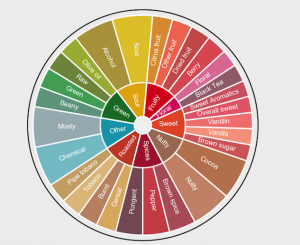
How can you change up your recipes and engage your eaters? Add new or favorite spice blends to dishes to give them an exciting lift! Don’t rely 100% on processed entrees to bring home the flavor. Increase your lunch numbers and build program financial health by bringing your customers back into the meal line with well-seasoned foods!
Nutrition and Food Facts:
- Spices are used in moderation and as a result do not have a lot of calories when added to dishes.
- Spices often contain minerals and micronutrients such as calcium, iron, and magnesium.
- Many spices contain antioxidants, such as flavonoids which can help the body absorb other nutrients.
- Black garlic is a savory version of garlic, without the harshness associated with white garlic.
Science:
- Turmeric powder has been surprisingly effective against Alzheimer’s symptoms in multiple studies, and currently out-performs any known Alzheimer’s drug.
- Some people greatly dislike the herb coriander, saying that it smells like soap and tastes like crushed bugs. This reaction has been linked to a particular set of genes in some people.
History and Lore:
- Ancient Greeks and Romans thought basil would only grow if you screamed wild curses and shouted while sowing the seeds.
- Despite being synonymous with blandness, vanilla is one of the most complex spices in the world and the second most expensive, next to Saffron.
- In ancient Rome, one of the most common cooking ingredients was called “laser”, from the silphium plant. It does not exist today. It was so delicious that it was harvested to extinction from its natural habitat in what is now Libya. We think that it probably tasted something like garlic.
A Seasoning How To-Primer
Why take precious time to create your own spice blends and flavoring profiles? When you combine multiple dry spices or fresh herbs to compliment your recipes you eliminate additives and higher sodium levels found in premade seasonings. The flavor will shine through when you prepare your own blends!
Develop Your Own Blends
By creating spice blends you can choose the heat level and intensity of the blends based on customer likes and dislikes. Different geographical areas and regions have their own specialty foods and cuisines. Ethnic populations influence your customer’s taste buds. By researching and understanding your community and region, you can determine what flavors, spices and dishes will be well received and will be reminiscent of recipes and practices at home.
Add a Balance Seasonings to the Dish When you rebuild entrees or sides with an understanding of how to adjust and balance your flavors you can not lose! Up until 2002, scientists recognized 4 ‘official’ tastes: 1) salty; 2) sweet; 3) sour; and 4) bitter. However, in 2002 umami was crowned the fifth flavor. Umami simply means yummy in Japanese, and it’s hard to describe what the flavor of umami tastes like. For simplicity sake, we are lumping it with salty in this lesson because they share a lot of the same flavor attributes.
If a flavor balances another flavor, it means it counteracts or offsets that flavor to achieve an even more harmonious taste. For example, spice balances sweet and sweet balances spice. It’s why Mexican hot chocolate is finished with a pinch of cayenne pepper – the spice works with the sweet to produce a more dynamic flavor.
Or if you have a dish that’s too spicy, you can also balance the heat with something sweet. So if you ever over-spice a curry or sauce, just add a bit of your preferred sweetener to neutralize the heat. Flavors can also enhance each other. If you look at the Flavor Star (shown below), you see that salty enhances sweet and vice versa. This is why there are sea salt caramels or sea salt chocolate chip cookies. That light addition of saltiness actually amplifies the sweetness of those caramels and cookies.
If you keep a Flavor Star handy, you can learn how to create more dynamic flavors, rescue dishes that have been overly flavored, and also how to amplify certain flavors.
Once you understand the ins and outs of seasoning in your cooking process your next step is to slowly incorporate scratch recipes for sauces, entrees, side dishes, and condiments. Seasoning blends can go a long way when served with tacos, pizza, soups, burritos, beverages, and other main entrees.
Spread the word and build partnerships
Don’t be a solo act. Invite your community to the table!
Promote in-house:
- Announcements
- Newsletters
- Website
- Social media
- Events (health fairs, open houses, garden working events, back to school, holiday activities, parents night, sporting events)
- Meetings (PTO, wellness committee, board of directors, staff professional learning days)
- Food tastings during events
Promote in your community:
- Report on activities and share pictures with news sources
- Share with community partners for their websites, social media and newsletters
- Post fliers at public places (libraries, health centers, non-profit hospitals, garden groups, local farm hubs, farmers markets, health agencies)
- Ask students to create and publicize local food stories – include photos or create videos
Invite others onsite to get involved:
- Build impact by engaging culinary arts, Future Farmers of America, wellness, botany, ecocentric and garden programs
- Create relationships and engage non-profit hospitals, garden groups, local farm hubs, farmers markets, health agencies and advocates
- Find support in local culinary leaders and businesses
Curricular Connections and Activities
Early childcare/preschool: Scholastic Activity Plan: Spice It Up
9-12: National Ag in the Classroom: Herbs & Spices of the World
6-12: Using Spices in the Kitchen Culinary Lesson
Menu Icons


REFERENCE CHARTS
Recipes
We have many recipes for you to explore in our Recipe Index! Be sure to check out more seasoning blends on the Spice It Up recipe index, too. Don’t forget to use the provided icons on your menu!
Featured Spice Blend Recipes:


